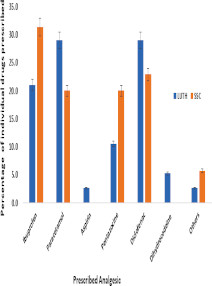Awareness and pattern of pentazocine use in patients with sickle cell disease in two sickle cell clinics in Lagos state, Nigeria
Keywords:
Sickle Cell Disease, Pentazocine use, Awareness, Analgesic, OpioidsAbstract
Background: Sickle cell disease (SCD) is a genetic disorder which leads to acute or chronic pain and thus requires the use of opioids and non-opioid medications. Pentazocine is a commonly used opioid among sickle cell patients for the management of moderate to severe pain. Patients understanding of the purpose and pattern of pentazocine use will encourage rational use and discourage misuse, especially outside the hospital setting. This study was set to assess the awareness and pattern of use of pentazocine among SCD patients.
Methods: The study was a cross-sectional, descriptive, questionnaire-based study conducted in two sickle cell clinics in Lagos State. A pretested questionnaire based on extant literature was employed to obtain patients sociodemographic data. Data was also obtained regarding prescribed medications, as well as patients' awareness and use of pentazocine. These data were analyzed using descriptive and inferential statistics in SPSS, version 21.0.
Results: Of the eighty respondents interviewed, most, 68 (85.0%) were single, 42 (52.5%) were females, and 50 (62.5%) had tertiary education. Mean age was 26.49 8.16 years. Commonly prescribed painkillers were Ibuprofen (31.4%), Paracetamol (28.9%), Diclofenac (26.9%) and Pentazocine (20.0%). Less than half, 32 (40%) were aware of pentazocine use in managing moderate to severe pain. Of these, 16 (50%) used it outside the clinic. 56.3% of those who used pentazocine outside the clinics used it because they had “unbearable pain”. There was a signifificant association between age and Pentazocine awareness (p = 0.02) but not use (p = 0.54). Respondents aged 21-30 years had better awareness of Pentazocine use compared to other age groups.
Conclusion:The awareness of pentazocine use among SCD patients in the two centers studied in Lagos, Nigeria was found to be inadequate despite its wide spread use outside the clinic without clinicians' supervision. Proper education on disease condition and its management should be encouraged among SCD patients to encourage appropriate use of pentazocine, as well as other analgesics used in the management of SCD and discourage misuse.
References
World Health Organization. (2006). Sickle-cell anaemia. Report by the Secretariat. Fifty-Ninth World Health Assembly. Geneva. http://apps.who.int/gb/archive/pdf_files/WHA59/A59_9-en.pdf. Accessed 19/12/2019
Piel FB, Hay SI, Gupta S, Weatherall DJ, Williams TN. (2013). Global burden of sickle cell anaemia in children under five, 2010-2050: modelling based on demographics, excess mortality, and interventions. PLoS Medicine. 10(7):e1001484.
https://doi:10.1371/journal.pmed.1001484
CDC, 2020. Data and Statistics on Sickle Cell Disease. Online https://www.cdc.gov/ncbddd/sicklecell/data.html. Accessed 30/07/2021.
Grosse SD, Odame I, Atrash HK, Amendah DD, Piel FB, Williams TN. (2011). Sickle cell disease in Africa: A neglected cause of early childhood mortality. American Journal of Preventive Medicine. 41(6S4):S398–405. https://doi:10.1016/j.amepre.2011.09.013
McGann, PT. (2016). Time to invest in sickle cell anemia as a global health priority. Pediatrics. 137(6): e20160348. https://doi:/10.1542/peds.2016-0348
Wastnedge E, Waters D, Patel S, Morrison K, Goh MY, Adeloye D, Rudan I. (2018). The global burden of sickle cell disease in children under five years of age: a systematic review and metaanalysis. Journal of Global Health, 8(2), 021103. https://doi:/10.7189/jogh.08.021103
Inusa BPD, Hsu LL, Kohli N, Patel A, OminuEvbota K, Anie KA, Atoyebi W. (2019). Sickle Cell Disease-Genetics, Pathophysiology, Clinical Presentation and Treatment. International Journal of Neonatal Screening. 5(2):20. https://doi: 10.3390/ijns5020020
Uwaezuoke SN, Ayuk AC, Ndu IK, Eneh CI, Mbanefo NR, Ezenwosu OU. (2018). Vasoocclusive crisis in sickle cell disease: current paradigm on pain management. Journal of Pain Research. 11:3141-3150. https://doi:/10.2147/JPR.S185582
Okpala I, Tawil A. Management of pain in sicklecell disease. (2002). Journal of the Royal Society of Medicine. 95(9):456-458. https://doi:10.1258/jrsm.95.9.456
Federal Ministry of Health (2016). Standard Treatment Guidelines for Nigeria. Second edition. Abuja: Federal Ministry of Health Nigeria.
Cumbler E, Wald H, Kutner J. (2010). Lack of patient knowledge regarding hospital medications. Journal of Hospital Medicine. 5(2):83-6. https://doi:10.1002/jhm.566
Bolshakova M, Bluthenthal R, Sussman S. (2019). Opioid use and misuse: health impact, prevalence, correlates and interventions. Psychology and Health. 34(9):1105-1139. https://doi:10.1080/08870446.2019.1622013
Adewoyin A, Adeyemi O, Davies N, Ojo M. (2019). Clinical and socio-demographic determinants of pentazocine misuse among patients with sickle cell disease, Benin City, Nigeria: a case-control study. The Pan African Medical Journal. 34:88. https://doi:10.11604/pamj.2019.34.88.17257
Makanjuol a AB, Ol a tunji PO. (2009). Pentazocine Abuse in Sickle Cell Anaemia Patients: Report of Two Case Vignettes. African Journal of Drug & Alconol Studies. 8(2). https://doi: 10.4314/ajdas.v8i2.52933
Akinbami A, Bola O, Uche E, Badiru M, Olowoselu O, Suleiman AM, Augustine B. (2019). Pentazocine Addition among Sickle Cell Disease Patients and Perception of Its Use among Health-Care Workers. Journal of Applied Hematology. 10(3): 94 - 98. https://doi:10.4103/joah.joah_39_19
Lagos State Government (2020). Population of Lagos State. www.lagosstate.gov.ng Accessed 23/02/2020
Haefeli M, Elfering A. (2006). Pain assessment. European Spine Journal.15 Suppl 1(Suppl 1), S17–S24. https://doi:10.1007/s00586-005-1044-x
Darbari DS, Brandow AM. (2017). Painmeasurement tools in sickle cell disease: where are we now? Hematology. American Society of Hematology. Education Program (1), 534–541. https://doi:10.1182/asheducation-2017.1.534
Nwagha T, Babatunde OI. (2020). Analgesia SelfMedication practice and pentazocine dependency in adult sickle cell patients in Southeast Nigeria. Nigerian Journal of Medicine. 29:197-202 https://doi:10.4103/NJM.NJM_1_20
Okonkwo CC, Lawal R, Ojo M, Eze C, Ladapo HT, Hary T, Nwigwe C, Ogunwale O, Ladeji E, Aguwa M. (2010). Substance Use among Students in a Public Senior Secondary School in Lagos, Nigeria. National Institute on Drug Abuse. United States Department of Health Publication. Accessed 15/04/2020
Geller AK, O'Connor MK. (2008). The sickle cell crisis: a dilemma in pain relief. Mayo Clinic Proceedings 83(3):320–323 https://doi:10.4065/83.3.320
Oshikoya KA, Edun B, Oreagba IA. (2015). Acute pain management in children with sickle cell anaemia during emergency admission to a teaching hospital in Lagos, Nigeria. South African Journal of Child Health. 9(4):119-123. https://doi:10.7196/SAJCH.2015.v9i4.968

Published
How to Cite
Issue
Section
License

This work is licensed under a Creative Commons Attribution-NonCommercial 4.0 International License.

